
Falling Hare is a 1943 Warner Bros. Merrie Melodies cartoon directed by Bob Clampett. The cartoon features Bugs Bunny.

Tortoise Wins by a Hare is a Merrie Melodies cartoon released on February 20, 1943, and directed by Bob Clampett. It stars Bugs Bunny and Cecil Turtle. It is a sequel to 1941's Tortoise Beats Hare, with footage from said cartoon briefly shown at the beginning. It is also the first short to feature Robert McKimson's design of Bugs Bunny.

A Wild Hare is a 1940 American animated comedy short film directed by Tex Avery, produced by Leon Schlesinger, and distributed by Warner Bros. as part of the Merrie Melodies series. The film was released on July 27, 1940, and features Elmer Fudd and Bugs Bunny, the latter making what is considered his first official appearance.

The Heckling Hare is a Merrie Melodies cartoon, released on July 5, 1941, and featuring Bugs Bunny and a dopey dog named Willoughby. The cartoon was directed by Tex Avery, written by Michael Maltese, animated by soon-to-be director Robert McKimson, and with musical direction by Carl W. Stalling. In a style that was becoming typical of the Bugs character, he easily outwitted and tormented his antagonist through the short, his only concern being what to do next to the dog.

Super-Rabbit is a 1943 Warner Bros. cartoon starring Bugs Bunny. The cartoon is a parody of the popular comic book and radio character Superman by DC Comics. Super-Rabbit was the 16th Bugs Bunny entry, and the 47th directed by Chuck Jones.
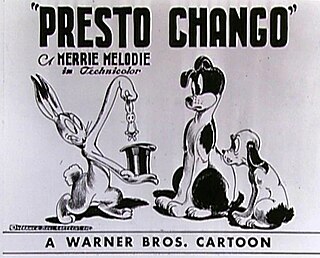
Prest-O Change-O is a 1939 Merrie Melodies cartoon directed by Chuck Jones, and first released on March 25, 1939, by Warner Bros. It is the second appearance of Bugs Bunny as a manic white hare who made his first appearance in Porky's Hare Hunt, a cartoon that was produced and copyrighted in 1937 and released in April 1938, featuring him in the same early design. This is also the character's first appearance in a Merrie Melodies color film. The prototype of Bugs Bunny the screwy rabbit makes his third appearance in the next hare-based short film, Hare-um Scare-um (1939).
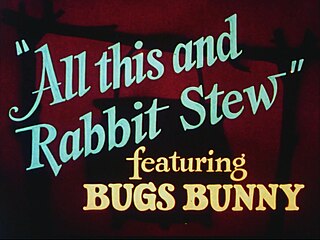
All This and Rabbit Stew is a 1941 Merrie Melodies cartoon directed by Tex Avery. The cartoon was released on September 13, 1941, and features Bugs Bunny.

Herr Meets Hare is a 1945 anti-Nazi Merrie Melodies cartoon directed by Friz Freleng. The short was released on January 13, 1945, and features Bugs Bunny. This short, released not long before the collapse of the Third Reich, was the penultimate wartime themed cartoon from Warner Bros. being released just under four months before Victory in Europe Day.

Slick Hare is a 1947 Merrie Melodies cartoon, directed by Friz Freleng. The film was released on November 1, 1947, and features Bugs Bunny and Elmer Fudd. It parodies the Mocambo nightclub in Los Angeles—in the cartoon referred to as "The Mocrumbo". Mel Blanc voices Bugs, Arthur Q. Bryan voices Elmer Fudd and impressionist Dave Barry portrays Humphrey Bogart. The title is a pun on "hair", from an era when hair slicked down by oil was a popular fashion style for men.

Hare Tonic is a 1945 Warner Bros. cartoon in the Looney Tunes series, directed by Chuck Jones and written by Tedd Pierce. It stars Bugs Bunny and Elmer Fudd, making this the second cartoon directed by Jones to co-star the two. Voice characterizations are by Mel Blanc and Arthur Q. Bryan.

Hare Force is a 1944 Warner Bros. cartoon in the Merrie Melodies series, directed by Friz Freleng. The cartoon was released on July 22, 1944, and stars Bugs Bunny.
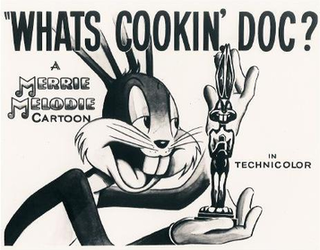
What's Cookin' Doc? is a 1943-produced, 1944 Warner Bros. cartoon in the Merrie Melodies series, directed by Bob Clampett, and stars Bugs Bunny. The short was also written by Michael Sasanoff, and was animated by Robert McKimson, along with uncredited work by Rod Scribner, Phil Monroe and Virgil Ross. The film was released on January 8, 1944.
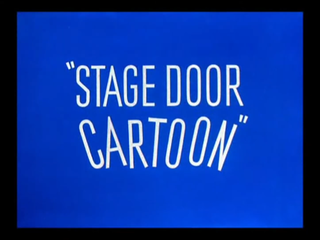
Stage Door Cartoon is a 1944 Merrie Melodies cartoon directed by Friz Freleng. The short was released on December 30, 1944, and features Bugs Bunny and Elmer Fudd.

A Hare Grows In Manhattan is a Warner Bros. cartoon in the Merrie Melodies series, released on March 22, 1947. It was produced by Edward Selzer and directed by I. Freleng. The short features Bugs Bunny.
The Unruly Hare is a 1945 Warner Bros. cartoon in the Merrie Melodies series directed by Frank Tashlin and written by Melvin Millar. The cartoon was released on February 10, 1945 and stars Bugs Bunny and Elmer Fudd. The film was one of only two Bugs Bunny cartoons directed by Frank Tashlin at Warner Bros., the other being 1946's Hare Remover.

Hare Conditioned is a 1945 Warner Bros. cartoon in the Looney Tunes series. It was directed by Chuck Jones.
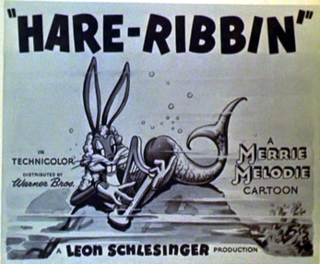
Hare Ribbin' is a 1944 animated short film in the Merrie Melodies series, directed by Robert Clampett and featuring Bugs Bunny. The plot features Bugs' conflict with a red-haired hound dog, whom the rabbit sets out to evade and make a fool of using one-liners, reverse psychology, disguises and other tricks. It was released in theaters by Warner Bros. on June 24, 1944. The title is a pun on "hair ribbon".

Buckaroo Bugs is a 1944 American Western Looney Tunes cartoon film directed by Bob Clampett. The cartoon was released on August 26, 1944, and features Bugs Bunny in his official Looney Tunes debut.

Hare Do is a 1949 Warner Bros. Merrie Melodies cartoon. The short was released on January 15, 1949, and stars Bugs Bunny and Elmer Fudd.

Bill of Hare is a 1962 Warner Bros. Merrie Melodies cartoon directed by Robert McKimson. The short was released on June 9, 1962, and stars Bugs Bunny and the Tasmanian Devil.


















